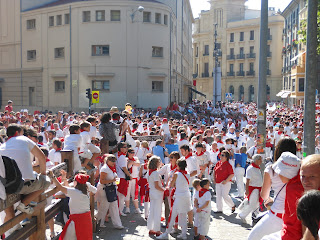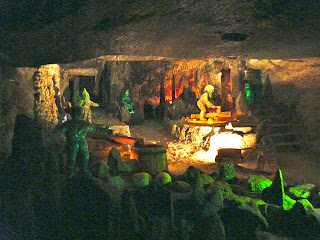Pamplona, Spain--The Running of the Bulls
One of the items on my "Bucket List" was checked off a few weeks ago in Spain. I have always wanted to go to the Running of the Bulls. While Mel was in the US, a friend and I went to Pamplona for the San Fermin Festival. The festival runs from July 6 to July 14. Ernest Hemingway's novel, The Sun Also Rises helped make the festival more famous. Hemingway enjoyed spending time in Pamplona and actually took lessons on bullfighting.
The encierro or Running of the Bulls, is held in a few cities in Spain, Portugal, and Mexico but Pamplona is the most famous. Each morning during the festival, six bulls and six steers run from their corrals on the edge of town, down the sectioned off streets, and into the bullfighting ring. The entire route is about 900 yards (a little more than 1/2 mile) and takes about 3 minutes (average). Anyone over the age of 18 can participate as long as you are not under the influence of alcohol (and are willing to assume the risks).
Spanish tradition says the origin began in North-eastern Spain during the early 14th century.
The encierro begins with runners singing a benediction. It is sung twice, once in Spanish and once in Basque. ("We ask Saint Fermín, as our Patron, to guide us through the encierro and give us his blessing"). The benediction is a prayer given at a statue of Saint Fermin, patron of the festival and the city, to ask the saint's protection. The singers finish by shouting “Viva San Fermín!, Gora San Fermín!”. Runners dress in the traditional clothing of the festival which consists of a white shirt and trousers with a red waistband and neckerchief.
A first rocket is set off at 8 a.m. to alert the runners that the corral gate is open. A second rocket signals that all six bulls have been released and are on the street. The third and fourth rockets are signals that all of the bulls have entered the bullring and finally, into the corral in the bullring, marking the end of the event. The herd is composed of the six bulls to be fought in the afternoon, six steers that run with the bulls, and three more steers that leave the corral two minutes after the first group. The function of the steers is to guide the herd. The average speed of the animals is 24 km/h (15 mph).
One of the items on my "Bucket List" was checked off a few weeks ago in Spain. I have always wanted to go to the Running of the Bulls. While Mel was in the US, a friend and I went to Pamplona for the San Fermin Festival. The festival runs from July 6 to July 14. Ernest Hemingway's novel, The Sun Also Rises helped make the festival more famous. Hemingway enjoyed spending time in Pamplona and actually took lessons on bullfighting.
The encierro or Running of the Bulls, is held in a few cities in Spain, Portugal, and Mexico but Pamplona is the most famous. Each morning during the festival, six bulls and six steers run from their corrals on the edge of town, down the sectioned off streets, and into the bullfighting ring. The entire route is about 900 yards (a little more than 1/2 mile) and takes about 3 minutes (average). Anyone over the age of 18 can participate as long as you are not under the influence of alcohol (and are willing to assume the risks).
Spanish tradition says the origin began in North-eastern Spain during the early 14th century.
The encierro begins with runners singing a benediction. It is sung twice, once in Spanish and once in Basque. ("We ask Saint Fermín, as our Patron, to guide us through the encierro and give us his blessing"). The benediction is a prayer given at a statue of Saint Fermin, patron of the festival and the city, to ask the saint's protection. The singers finish by shouting “Viva San Fermín!, Gora San Fermín!”. Runners dress in the traditional clothing of the festival which consists of a white shirt and trousers with a red waistband and neckerchief.
A first rocket is set off at 8 a.m. to alert the runners that the corral gate is open. A second rocket signals that all six bulls have been released and are on the street. The third and fourth rockets are signals that all of the bulls have entered the bullring and finally, into the corral in the bullring, marking the end of the event. The herd is composed of the six bulls to be fought in the afternoon, six steers that run with the bulls, and three more steers that leave the corral two minutes after the first group. The function of the steers is to guide the herd. The average speed of the animals is 24 km/h (15 mph).
Every year, between 200 and 300 people are injured during the run although most injuries are bumps and bruises due to falls and are not serious. Some of the more serious injuries are from being gored by the horns of the bulls. Since record-keeping began in 1924, 15 people have been killed in Pamplona–– most recently on 10 July 2009.
The streets of Pamplona are filled with people enjoying the festival.
Festival time
Street band
People pour water from the balconies onto the waiting crowds below
The San Fermin Festival
The Gringo in Spain-dressed like a native
An old church in Pamplona--near the corrals where the Running of the Bulls begins
A street band playing during the night. The partying went on all night.
Even the little ones come out to enjoy the fun.
Senor Testes (that is his actual name)
A young boy on his father's shoulders
The carnival during the festival
6 am--crowds already gathered for the 8 am Running of the Bulls
Angus and friend getting ready for the run
Many people rent the balconies to watch the run.
The balconies provide a good vantage point to watch the action.
Anticipation!! A few minutes until show time.
The bulls are loose. Time to get moving.
Here come the bulls
Survived the Running of the Bulls-Day 1
Found my friend--thankfully, he survived as well
Statue of the Running of the Bulls
Crowds on the streets before the bullfight
Plenty of police to control the crowds
Every afternoon between the 7th and 14th of July, there is a bullfight in which the 6 bulls that have been driven to the bullring during the bullrunning of that day are killed. The bullring in Pamplona holds about 19,000 people and is the third largest in the world behind Madrid and Mexico City. It is said to be full every afternoon and
tickets are hard to find.
Inside the Bullring
The Matadors and their entourage
The Picadors
Matador fighting the bull while the Picador watches
Bull charging the mounted Picador
On his knees
A quick turn by the bull--oh, oh.....
I love the pink pants
The crowd shows its appreciation for the skills of the Matador
As mentioned, going to the Running of the Bulls in Pamplona was on my bucket list. My friend and I ran with the bulls twice. On day two, 3 people were gored when one of the bulls slipped early in the run and became separated from the rest of the herd. He ended up goring the runners when he became upset. It took him about 5 minutes to make his way into the bullring.
Although not on my bucket list, I had never been to a bullfight before. It was interesting to watch this part of Spanish culture and history. Today's people have a hard time understanding and appreciating bullfighting but it is an art that takes years to perfect.





















































































